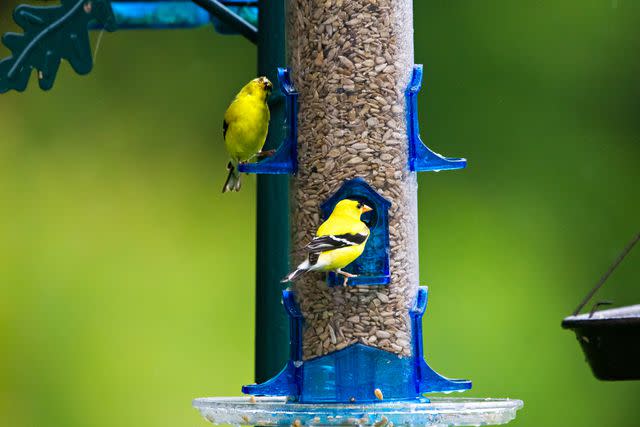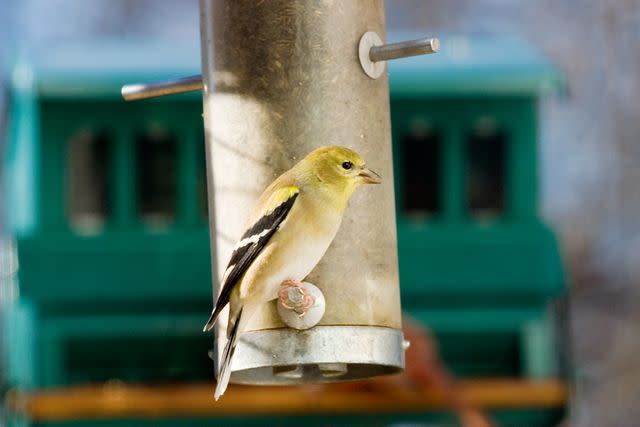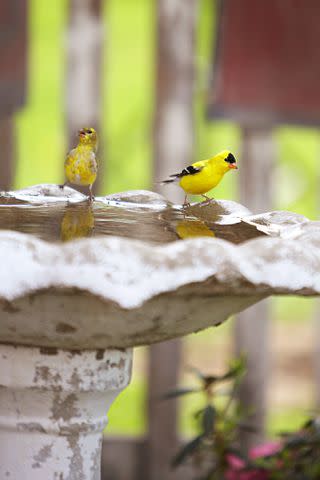How to Attract Goldfinches for Backyard Birdwatching
Bird experts share their best tips on how to attract goldfinches to your garden.
Putting up a bird feeder with the right kind of seeds is one easy way to attract goldfinches to your yard. But there are several more things you can do to draw in these beautiful songbirds. These expert tips will help you choose the best types of feeders, seeds, plants, water sources, and nesting materials for attracting goldfinches.

Rob Cardillo
What Are Goldfinches?
A part of the songbird family, goldfinches are a type of bird from the genus Carduelis. There are four types of goldfinches in the world, and three can be found in the United States—American, lesser, and Lawrence’s goldfinch. Of these, American goldfinches are the most common and likely the bird you'll find visiting your backyard.
American goldfinches stand out for their bright colors and their sounds; they are songbirds, after all. “During the spring and summer, they become more brightly colored, with orange bills and males sporting canary-yellow and black plumage,” says Dr. Charles van Rees, a conservation scientist and naturalist. It’s not only their plumage that sets them apart. Goldfinches don’t snack on worms or insects like other birds; they feast on seeds.
Meet the Experts
Charles van Rees, Ph.D., is a conservation scientist and naturalist who has studied birds in the U.S. and abroad for 14 years. He is the founder of Gulo in Nature.
Chris Earley, zoologist, is an adjunct professor of integrative biology at the University of Guelph and the author of several books, including Feed the Birds: Attract and Identify 196 Common North American Birds.

David Speer
Attracting Goldfinches with Feeders
Whether you’ve been attracting birds to your backyard for years or are just starting, goldfinches are relatively easy to lure to a bird feeder. “American goldfinches will readily come to bird feeders all year around,” says van Rees. “A good birdfeeder can supply almost all of their needs.” That’s because they love eating seeds, which are the base of their diet. “Their favorite foods are nyjer seeds in a tube feeder and black oil sunflower seeds—both in the shell and without the shell—in either a tube feeder or a hopper feeder,” says Chris Earley, a zoologist and professor at the University of Guelph.
Related: The 15 Best Bird Feeders to Attract Cardinals, Hummingbirds, Finches, and More to Your Yard
Nyjer seeds are tiny, black seeds that are highly nutritious and provide goldfinches plenty of energy. Nyjer seeds are often referred to as thistle seeds, but they don’t come from the thistle plant; instead, they come from the African yellow daisy (Guizotia abyssinica). In the colder months, goldfinches eat a lot of thistle or nyjer seeds. “Thistle seeds will draw them in great numbers, especially during the winter,” says van Rees.
Sometimes goldfinches won’t eat from a feeder, and there could be a couple of reasons. Birds need to feel safe and protected from predators—such as hawks or cats—before venturing to a feeder, so avoid placing one in an open area. An ideal spot is near small trees or shrubs so they can easily hide if needed.
The freshness of seeds is also important. “If the seed has been sitting in the feeder too long, goldfinches might avoid it,” says van Rees. “They prefer fresh thistle seeds, so replacing these at least weekly is a great way to ensure you attract them.” You also want to keep the feeder clean.
Best Plants for Attracting Goldfinches
Besides using feeders to bring goldfinches to your yard, the birds are also attracted to some plants, so try growing their preferred flowers. “Sunflowers and other large-flowered plants from the aster family, such as black-eyed Susans, are a great way to attract goldfinches,” says van Rees. “Flowers like coneflowers, thistles, and cosmos are likely to provide a reliable food source that will encourage them to stay.”
Another favorite food source, according to Earley, is the cup plant (Silphium perfoliatum), a tall native species with yellow, sunflower-like blooms that produce lots of seeds. As a bonus, cup plant has leaves that join together around the stem to form a small cup that hold rain water for thirsty birds.

Marty Baldwin
Water Sources
Another consideration for attracting goldfinches is providing a water source for them to drink from and bathe. “Goldfinches will use a variety of containers for drinking and bathing, but these should only be one to two inches deep, especially for bathing,” says Earley.
Before placing out a water basin or a bird bath, consider the location and make sure it’s not easily reachable by cats and other creatures that like to eat birds. Elevating them from the ground makes them safer, explains van Rees, and don’t overfill them. “Make sure they are shallow, so they are safe for the birds to bathe in without risk of getting stuck in too much water,” says van Rees.
You’ll also want to create varying height levels in the bird bath, especially if you want many bird species to have access to the water. “Because different birds are different sizes, adding flat stones to a bird bath so there are different depths will allow more species to use the water source for bathing,” says Earley. “Goldfinches will use a heated bird bath in the winter.”
Related: The 15 Best Bird Baths of 2023 for a Stylish, Bird-Friendly Garden
Nesting Materials and Habitat
Some birds are cavity-nesting and will use a birdhouse, but goldfinches aren’t so they won’t reside in nest boxes or birdhouses. Goldfinches prefer to build their own nests.
“Goldfinches like to nest in tall shrubs and small trees,” says van Rees. “In my experiences out in the wild, I have often found their nests at around 6 feet in height up to maybe 9 or 10 feet, and often surrounded by thorny plants and brambles.”
What type of nesting material do goldfinches use? “The main material in goldfinch nests is thistledown [because] this material makes the nests quite strong and very soft inside,” says Earley. They also rely on other materials for building their nest. “Like many other songbirds they like to use plant fibers, like pieces of grass, to line the nest cup, and moss, animal hair, and plant rootlets for some of the finer detail work,” says Van Rees. “If you’d like to encourage goldfinches to nest on your property, you’ll want to have some open spaces with almost meadow-like cover and nearby shrubs for nesting.”
The goldfinches’ access to food influences when they have their young, which is later in the year compared to other birds. “Many of their food sources, including thistles, do not produce seeds until later in the season, and seeds are very important for raising baby goldfinches,” says Earley. “Young American goldfinches do fine without eating insects, but this means nesting in late summer at the highest productivity time for their favorite seeds.”
Frequently Asked Questions
Why won’t goldfinches come to my bird feeder?
Birds need to feel protected and safe before visiting a bird feeder. If your bird feeder is out in the open without many shrubs or trees nearby, this could be a reason why they aren’t visiting. Also, if you have cats in the neighborhood, these predators can make goldfinches hesitant to visit.
Will suet attract goldfinches in winter?
In fall and winter, goldfinches are attracted to suet. Put it out in a shady space to delay spoilage and replace any remaining suet after two weeks. Goldfinches also enjoy a consistent diet of seeds throughout the year.
For more Better Homes & Gardens news, make sure to sign up for our newsletter!
Read the original article on Better Homes & Gardens.

